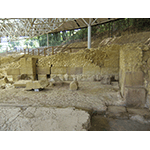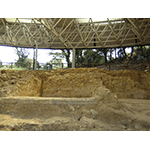Etruscan-Roman Thermal Baths of Sasso Pisano
At the centre of a fascinating territory abounding in natural springs, where geothermal sources have been traditionally exploited, the exceptional Sasso Pisano complex constitutes the only surviving example of Etruscan baths from the late Hellenic Age.
Dating from still more ancient times (III century B.C.) are the remains of a quadrangular portico of the Doric order consisting of great squared blocks of local limestone, to which were added, in the II century B.C, two thermal installations with pools and service facilities, covered by tiled roofs. These structures were flanked by numerous quadrangular rooms, probably used to receive visitors and pilgrims.
The complex hydraulic system, designed to exploit the nearby warm-water springs, is extremely interesting. Limestone channels conveyed the water to the pools used for bathing and to the great outdoor fountain on one side of the portico.
Abandoned for almost a century after having been damaged by a seismic event in the second half of the I century B.C., the complex, partially rebuilt, remained in use throughout the 3rd century A.D., as proven by a group of 64 bronze coins dating from that time found in one of the discharge channels.
The seal with the Etruscan inscription spural (literally, "of the city") huflunas appearing on numerous roofing tiles seems to indicate that the baths were public. The complex is probably to be identified as the Aquae Volaterrae or the Aquae Populoniae represented in the Tabula Peutingeriana, a medieval copy of a map from Roman Imperial times now in the Vienna National Library.
A project for creating in this area an archaeological park open to visitors, which will further enrich the already notable tourist attraction of the territory, is now being implemented.
****************************
Texts by Elena Fani
English translation by Catherine Frost
Last update 16/feb/2008





